 |
Home | Charity | Feedback |
Italy:
Bellagio,
Bolzano,
Burano,
Como,
Dolomites,
Florence,
Italian Riviera,
Lake Como,
Menaggio,
Monterosso,
Murano,
Ortisei,
Passo Falzarego,
Pisa,
Portofino,
Riomaggiore,
San Gimignano,
Santa Margherita Ligure,
Selva di Val Gardena,
Varenna,
Venice,
Verona,
Villa Carlotta
Venice, Italy: Seat of romance by Prakash Bang, Editor in Chief 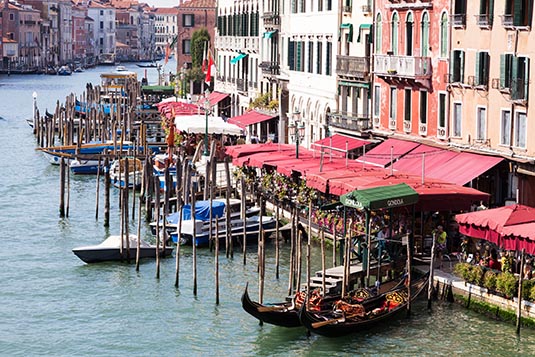 Venice (Venetia to Italians) is one of the most interesting and lovely places in the world. This sanctuary on a lagoon is virtually the same as it was six hundred years ago, which adds to the fascinating character. Venice has decayed since its heyday with influx of tourists stealing the show (there are more tourists than residents), but the romantic charm certainly remains. 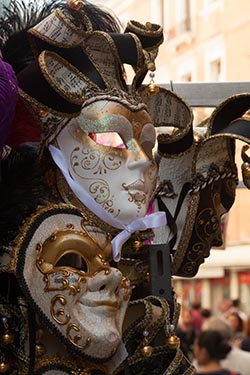 We drove from Bolzano to Mestre and checked into our Hotel Tritone, just across the Mestre railway station. Mestre would be our base for the next 3 nights and 2 days. From here we would explore the islands of Venice, Burano and Murano. There’s a parking lot next to the hotel, which makes it more convenient. Venice is on a lagoon, the water plays a crucial role in transportation… one doesn’t need a car to explore Venice. Just so you know, Venice is the world’s only pedestrian city!
We drove from Bolzano to Mestre and checked into our Hotel Tritone, just across the Mestre railway station. Mestre would be our base for the next 3 nights and 2 days. From here we would explore the islands of Venice, Burano and Murano. There’s a parking lot next to the hotel, which makes it more convenient. Venice is on a lagoon, the water plays a crucial role in transportation… one doesn’t need a car to explore Venice. Just so you know, Venice is the world’s only pedestrian city!
Venice is made of different boroughs. The most famous is the area comprising the 118 islands in the main districts that are called "Sestieri" and they are: Cannaregio, Castello, Dorsoduro, San Polo, Santa Croce and San Marco, where the main monuments and sights are located. Other main districts are Isola Della Giudecca and Lido di Venezia. And important islands include Murano, Torcello, San Francesco del Deserto, Burano amongst others. Republic of Venice dates back to 827, when a Byzantine Duke moved its seat to what is now known as Rialto, and for the following 970 years, prospered on trade under the rule of a Roman-style Senate headed by the Doge. In 1797, the city was conquered by Napoleon, a blow from which it never recovered. The city was soon merged into Austria-Hungary, then ping-ponged back and forth between Austria and a nascent Italy, but Venice is still a monument to the glory days of the Renaissance. 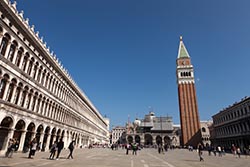 After breakfast next morning, the first thing we did was grab a 24-hour travel card. The cost was Euro 20 that entitled us for unlimited travel on local buses and vaporetti (water buses). With this card we would be able explore Venice as well as other islands.
After breakfast next morning, the first thing we did was grab a 24-hour travel card. The cost was Euro 20 that entitled us for unlimited travel on local buses and vaporetti (water buses). With this card we would be able explore Venice as well as other islands.
We boarded bus no. 2, just outside of Mestre station and in 15 minutes we were at Piazzale Roma, on the west bank of Venice. From here we took the vaporetti that zipped us through the Grand Canal to Rialto. There are water taxis available, but they are expensive. The best way is to take a walk! The city is not that big, and you can walk from one end to the other in a few hours (if you stick to the paths conveniently marked with arrows in the direction of major landmarks). But it would take months for a fit person to discover every path in the city. Along the way you will discover marvelous art, superb architecture and breathtaking urban landscaping. Exploring the city randomly by walking is well worth it but also be prepared to get lost easily! Signs all over the city indicate the direction to the main attractions, "Rialto" and "San Marco", as well as the way back to the train station ("ferrovia") and the bus terminal ("Piazzale Roma"). These signs make it easy to have the "get lost experience" even as a one-day tourist. 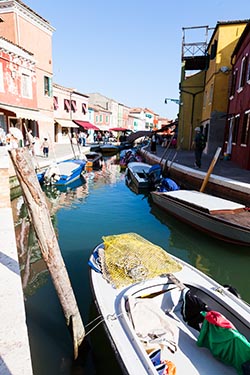 Be aware that addresses in Venice are of the form DISTRICT number (The Venetian word for district is "Sestriere"), not STREET number. To find a specific place using a map, make sure you know which district it is in. The numbers are assigned at the start of the district and increase as they move farther away from the Grand Canal.
Be aware that addresses in Venice are of the form DISTRICT number (The Venetian word for district is "Sestriere"), not STREET number. To find a specific place using a map, make sure you know which district it is in. The numbers are assigned at the start of the district and increase as they move farther away from the Grand Canal.
We commenced our walk from Rialto towards San Marco. Negotiating a maze of streets we did reach our destination, finally. The Rialto market and the Rialto Bridge (Ponte di Rialto for locals) on San Polo is the smallest sestiere. The Rialto market is for shoppers. To the east is a neighborhood of small shops and restaurants; to the west is the Rialto farmers' market. Shopping is slightly less expensive than in the tourist-filled Piazza San Marco. The commonest local specialties are carnival masks, glass, and marbled paper. The bridge has become one of Venice's most recognizable icons and has a history that spans over 800 years. Today's Rialto Bridge was completed in 1591 and was used to replace a wooden bridge that collapsed in 1524. 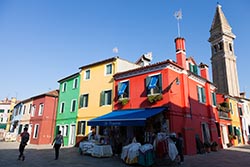 Piazza San Marco, often known in English as the St. Mark's Square, is the principal public square of Venice. It is generally known just as "the Piazza" (la Piazza). All other urban spaces in the city (except the Piazzetta and the Piazzale Roma) are called "campi" (fields). The Piazzetta (the 'little Piazza') is an extension of the Piazza towards the lagoon in its south east corner. The two spaces together form the social, religious and political centre of Venice and are commonly considered together.
Piazza San Marco, often known in English as the St. Mark's Square, is the principal public square of Venice. It is generally known just as "the Piazza" (la Piazza). All other urban spaces in the city (except the Piazzetta and the Piazzale Roma) are called "campi" (fields). The Piazzetta (the 'little Piazza') is an extension of the Piazza towards the lagoon in its south east corner. The two spaces together form the social, religious and political centre of Venice and are commonly considered together.
Amongst the main attractions at the Piazza are St Mark's Basilica, the Clock Tower (Torre dell'Orologio), Procuratie Vecchie (former homes and offices) and the Campanile. Be prepared to wait for hours (in high season, as we were in) to be able to get the tickets to visit the Basilica, Campanile and the Clock Tower. The lucky ones get to see the panorama of Venice from up above… breathtaking, I can imagine. 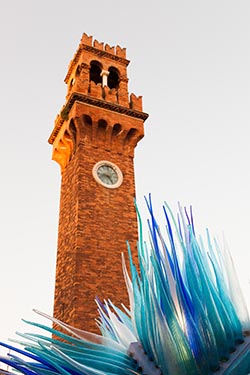 From the Piazza we walked towards the piers on Riva Degli Schiavoni that faces the Adrian Sea. It’s near this shore where the Grand Canal merges with the sea. Just across the famous Ponte (bridge) Della Pagila, we took the waterbus for the Burano Island – a 45-minute boat ride before we could see the colourful shores of Burano.
From the Piazza we walked towards the piers on Riva Degli Schiavoni that faces the Adrian Sea. It’s near this shore where the Grand Canal merges with the sea. Just across the famous Ponte (bridge) Della Pagila, we took the waterbus for the Burano Island – a 45-minute boat ride before we could see the colourful shores of Burano.
Like Venice itself, Burano could more correctly be called an archipelago of four islands linked by bridges. It is situated near Torcello at the northern end of the Lagoon, and is known for its lacework and brightly coloured homes. Although the island of Burano soon became a thriving settlement, it was administered from Torcello and had none of the privileges of that island or of Murano. It rose in importance only in the 16th century, when women on the island began making lace with needles, being introduced to such a trade via Venetian-ruled Cyprus. When Leonardo da Vinci visited in 1481, he visited the small town of Lefkara and purchased a cloth for the main altar of the Duomo di Milano. The lace was soon exported across Europe, but trade began to decline in the 18th century and the industry did not revive until 1872, when a school of lacemaking was opened. Lacemaking on the island boomed again, but few now make lace in the traditional manner as it is extremely time-consuming and therefore expensive. 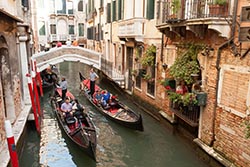 Burano is also known for its small, brightly painted houses, popular with artists. The colours of the houses follow a specific system originating from the golden age of its development; if someone wishes to paint their home, one must send a request to the government, who will respond by making notice of the certain colours permitted for that lot.
Burano is also known for its small, brightly painted houses, popular with artists. The colours of the houses follow a specific system originating from the golden age of its development; if someone wishes to paint their home, one must send a request to the government, who will respond by making notice of the certain colours permitted for that lot.
After exploring the island and a quick lunch at one of the pizzerias, we took another waterbus to reach Murano. Murano is composed of seven islands, linked by bridges, separated by eight channels. Murano was initially settled by the Romans and from the sixth century by people from Altinum and Oderzo. At first, the island prospered as a fishing port and through its production of salt. It was also a centre for trade through the port it controlled on Sant'Erasmo. From the eleventh century, it began to decline as islanders moved to Dorsoduro. It had a Grand Council, like that of Venice, but from the thirteenth century, Murano was ultimately governed by a podesta from Venice. Unlike the other islands in the Lagoon, Murano minted its own coins. 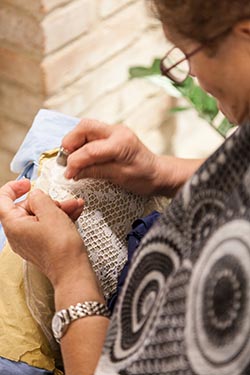 Early in the second millennium hermits of the Camaldolese Order occupied one of the islands, seeking a place of solitude for their way of life. There they founded the Monastery of St. Michael (Italian: S. Michele di Murano). This monastery became a great center of learning and printing. The famous cartographer, Fra Mauro, whose maps were crucial to the European exploration of the world, was a monk of this community. The monastery was suppressed in 1810 by French forces under Napoleon, in the course of their conquest of the Italian peninsula, and the monks were expelled in 1814. The grounds then became Venice's major cemetery.
Early in the second millennium hermits of the Camaldolese Order occupied one of the islands, seeking a place of solitude for their way of life. There they founded the Monastery of St. Michael (Italian: S. Michele di Murano). This monastery became a great center of learning and printing. The famous cartographer, Fra Mauro, whose maps were crucial to the European exploration of the world, was a monk of this community. The monastery was suppressed in 1810 by French forces under Napoleon, in the course of their conquest of the Italian peninsula, and the monks were expelled in 1814. The grounds then became Venice's major cemetery.
In 1291, all the glassmakers in Venice were forced to move to Murano due to the risk of fires. In the following century, exports began, and the island became famous, initially for glass beads and mirrors. Aventurine glass was invented on the island, and for a while Murano was the main producer of glass in Europe. The island later became known for chandeliers. Although decline set in during the eighteenth century, glassmaking is still the island's main industry. 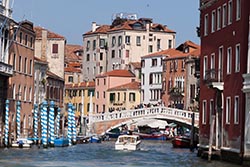 We were back in Venice at 7PM. How can a visit to this romantic place be complete without a ride on a gondola? About a 20-minute gondola ride in some of the inner canals of Venice would cost Euro 80 during daytime and Euro 100 post 7 PM. It indeed is expensive. Though we were advised that bargains can be struck with gondala owners, we were unsuccessful. Each one of them had a printed rate card and they wouldn’t budge on the price… thanks to the hordes of tourists. Anyway, we took the ride. The experience was necessary!
We were back in Venice at 7PM. How can a visit to this romantic place be complete without a ride on a gondola? About a 20-minute gondola ride in some of the inner canals of Venice would cost Euro 80 during daytime and Euro 100 post 7 PM. It indeed is expensive. Though we were advised that bargains can be struck with gondala owners, we were unsuccessful. Each one of them had a printed rate card and they wouldn’t budge on the price… thanks to the hordes of tourists. Anyway, we took the ride. The experience was necessary!
Following a reverse-order of our morning travels, we reached our hotel at about 10 PM. Tomorrow we would be visiting Italy’s another beautiful city - Verona. Venice Image Gallery  Photo viewer Photo viewer
Burano Image Gallery  Photo viewer Photo viewer
Murano Image Gallery  Photo viewer Photo viewer
|
|
|
Home |
Charity |
Feedback
Privacy Policy | Terms of Usage © YoGoYo.com. All rights reserved. |







































































